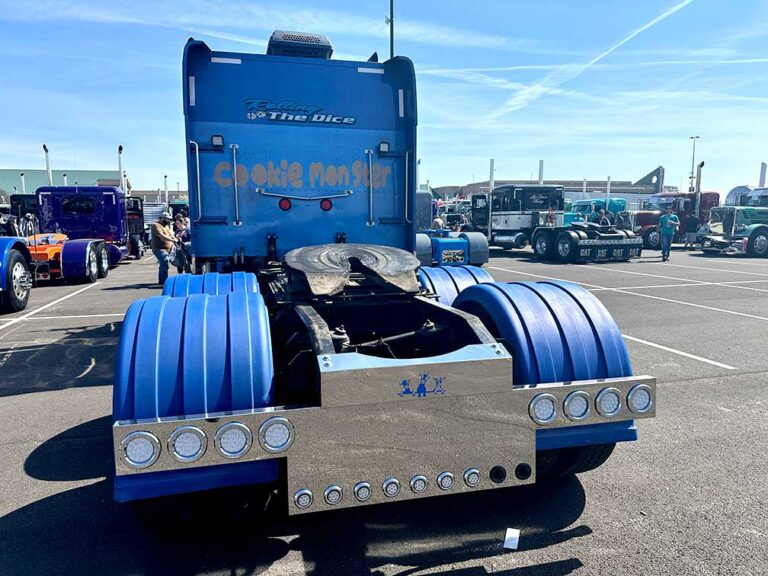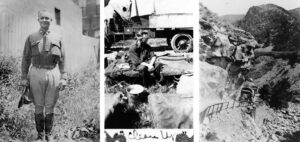It’s one of the most important inventions in the history of trucking: The fifth wheel bears the brunt of cargo weight as it’s transferred from the trailer to the vehicle that’s hauling the trailer.
Today’s fifth wheels are so reliable that they’re often taken for granted, other than regular cleaning and greasing.
But that wasn’t always the case.
The modern fifth wheel hitch was developed not over a period of years — or even decades — but over centuries, with each version improving on what had been accomplished before. It’s a development that makes attribution to a single inventor a difficult and controversial effort.
Charles Martin is credited with the patent of the modern fifth wheel.
Born in 1867 in Findlay, Ohio, Martin got his start in the business world as a traveling salesman, first selling groceries for a wholesale company. He later went to work for the W.J. White Chewing Gum Co. This position took him to Europe where he was sent to market the company’s product.
In 1899, he reached a turning point in his career. He developed an interest in a recent invention back in the U.S. — the motorized automobile.
Martin’s obsession with America’s newfound source of transportation took him to Springfield, Massachusetts. There, together with Honsdale Smith, he purchased the Knox Motor Co. Martin is credited with carrying the company name to Puerto Rico, where he introduced the island to automobiles.
But it was his later work — as a mechanical engineer — that brought about his source of fame in the motor vehicle world.
Martin moved from Knox to the Morgan Truck Co. It was there he designed a three-wheeled road tractor. Coincidentally, he sold the tractor to Knox Motor Co., and it became widely known as the “Knox Motor Tractor.”
In the meantime, Herman Farr, a former colleague of Martin’s at Knox, developed a fifth-wheel design. However, Farr’s invention received little fanfare in its early years.
By 1915 Martin and Farr had teamed up to form the Martin Rocking Fifth Wheel Co., which was among the first businesses to specialize in the fifth wheel. Martin patented Farr’s invention — for which Farr was credited by being named secretary of the company.
Incidentally, the Martin Co. also developed an early automobile known as the “Scootmobile,” a 150-pound vehicle capable of traveling 35 miles per hour and getting 75 miles per gallon. The speed and efficiency of the vehicle never caught on, however, so Martin returned to manufacturing fifth wheels.
This turned out to be a wise choice: The Fruehauf semi-trailer company soon started using Martin’s fifth wheel exclusively. By 1916, the Martin-Farr design was used to haul almost every trailer on the country’s roadways.
Soon after starting to do business with Fruehauf, Martin decided to try his hand at manufacturing semi-trailers. As with the Scootmobile, this sideline business didn’t last long. Fruehauf claimed copyright infringement. Martin, facing a fight with his best customer, abandoned the trailer business.
Once again, he returned to manufacturing fifth wheels.
What set the Martin Rocking Fifth Wheel apart from earlier versions was — as its name implies — that it rocked horizontally or laterally on hinges. This made traveling the rough roads of the early 20th century more comfortable for the driver and easier on the equipment.
The Martin fifth wheel’s claim to fame, however, was that the easier ride resulted in less damage to cargo. Martin claimed his fifth wheel cut hauling costs in half.
To find the early designs for coupling mechanisms, however, you have to go back centuries.
Pivoting front axles were recognized as a necessity for efficient travel by carriage long before Martin and Farr ever dreamed of the self-coupling design that’s the standard of the trucking industry today.
The first coupling that allowed for pivoting axles was used in ancient Rome where a “kingpin” attached a chariot to the animal pulling the vehicle. This use continued into the Middle Ages.
In the 18th century, a wheel plate was added to the Roman design, improving the strength, stability and weight-carrying capacity of the early fifth wheel.
An alternate design allowing for pivoting front wheels was created in 1758 by Erasmus Darwin. (To answer your question, yes, he was the grandfather of Charles Darwin.) Darwin’s design featured two front wheels that pivoted independently. But the design was unstable and didn’t catch on.
By 1837, the production of fifth-wheel devices had traveled across the Atlantic Ocean to the U.S., where Brown and Hicks came up with a design to reduce road vibrations.
Then, in 1850 the Everett Carriage Co. improved on the design, as did Gutches in 1870 with the introduction a metallic hard block. Improvements continued with the Herbrand Fifth Wheel Co. in the 1880s — and in 1905 the Wilcox fifth wheel was introduced.
But it was Charles Martin’s patent in 1915 that revolutionized trucking.
Each design of the fifth wheel to this point had several goals, and Martin attempted to incorporate all of them. A small turning radius, ride handling, lubrication points and a design that was as lightweight as possible — all were featured in fifth wheels sold by the Martin Rocking Fifth Wheel Co.
Today’s fifth wheels feature a U-shaped design that allows a tractor to be simply backed into a trailer’s kingpin, where it’s automatically locked in place by a coupling. The design alleviates the need to lift a trailer slightly and maneuver the vehicle to allow the kingpin to be lowered into place.
The advent of automatic coupling makes possible the modern era’s need to “hook and go” in a short time span, allowing for quick drop-offs and transfer of cargo between vehicles.
So, while Charles Martin may be credited with the modern fifth wheel design, it should be remembered that he did not, in fact, invent the coupling device. It was his partner, Herman Farr, who is truly the father of the modern fifth wheel — but even Farr simply improved on designs that came before his own.
The history of the fifth wheel does not end there.
Another 20th-century inventor, Dick Rubbins of Alaska, claimed to be the actual inventor of the modern fifth wheel. He was so adamant in his demand for recognition that he took his angst to his grave.
The epitaph on his headstone, at least according to legend, reads “Here lies Dick Rubbins, inventor of the fifth wheel and holder of 19 other patents. I am buried face down so that Charles Martin can kiss my royal Irish ass.”
The tumultuous history of the fifth wheel continues.
Since retiring from a career as an outdoor recreation professional from the State of Arkansas, Kris Rutherford has worked as a freelance writer and, with his wife, owns and publishes a small Northeast Texas newspaper, The Roxton Progress. Kris has worked as a ghostwriter and editor and has authored seven books of his own. He became interested in the trucking industry as a child in the 1970s when his family traveled the interstates twice a year between their home in Maine and their native Texas. He has been a classic country music enthusiast since the age of nine when he developed a special interest in trucking songs.















